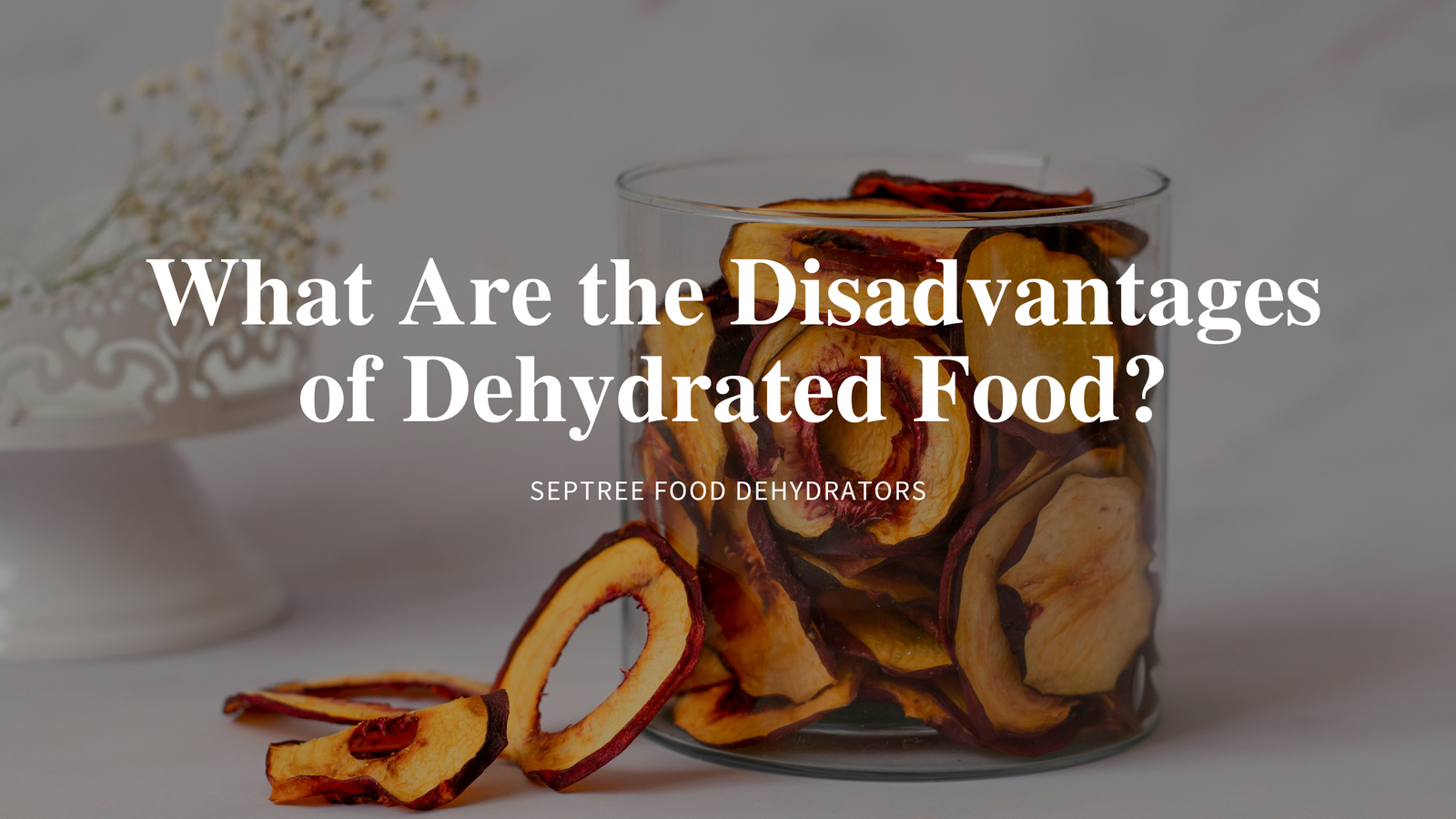What Are the Disadvantages of Dehydrated Food?

Dehydrated foods are in trend nowadays for their convenience, long shelf life, and easy storage. Like every other thing, despite having numerous advantages, dehydrated foods also have disadvantages. In this article, we will talk about the disadvantages briefly that you need to know before using dehydrated foods.

Common disadvantages of dehydrated food
Some common disadvantages of dehydrated foods include:
- Loss of nutrients
- Health issues
- Changes in texture and taste
- Safety and storage risks
Loss of nutrients
The dehydration process can cause the loss of important vitamins and minerals. The loss depends on temperature, dehydration time, and type of food.
1. Vitamin and mineral degradation
Fat-soluble vitamins like Vitamin A and E degrade by heat, which affects their antioxidant properties. Water-soluble vitamins like Vitamin C and B-complex degrade quickly during dehydration which reduces their health benefits. Some minerals like calcium and iron may be lost or become less bioavailable after dehydration
Blanching vegetables before drying is often used to retain color and texture, which causes additional nutrient loss. However, the dehydration process extends the food’s shelf life. But it cannot preserve all the nutrients.
To reduce nutrient loss, use low temperatures and store food properly. If you want to start dehydrating, you can try out the Septree food dehydrator, which helps you control the temperature accurately.

2. Changes in fiber and protein
Dehydration removes water but keeps the fiber mostly the same. That means the food shrinks in size which makes it easy to overeat. That can lead to consuming more calories than you intended.
Proteins generally withstand the dehydration process well. But their texture and taste can be affected which might change their digestibility.
Health issues
Eating too much-dehydrated food can cause some real health issues. And that is especially true if you are not drinking enough water.
1. High sugar concentration
Dehydrating fruits concentrate their natural sugars which increases their glycemic index. For example:
|
Food Type |
Fresh (Per Cup) |
Dried (Per 1/4 Cup) |
|
Blueberries |
15g sugar, 84 kcal |
27g sugar, 127 kcal |
|
Apples |
13g sugar, 52 kcal |
25g sugar, 105 kcal |
This sugar concentration can lead to blood sugar spikes that make dehydrated fruits less suitable for diabetes people or those watching their sugar intake very closely.

2. Additives and preservatives
Salt is used as a preservative in dried foods, especially in meat. It adds flavor and keeps food last longer. However, too much sodium intake can increase blood pressure and heart problems. For example, one ounce of dried beef has 791 milligrams of sodium. That is 34% of the daily limit which is 2,300 milligrams.
Many commercial dehydrated foods also have extra chemicals like sulfites. These help to maintain color and extend the shelf life of food. But some people are allergic to them.
Changes in texture and taste
Dehydrated food feels and tastes very different from fresh food. Fruits often turn chewy or feel like leather. Vegetables can go hard and break easily. Sometimes dehydrated food loses its natural smell. Drying makes the flavor stronger but sometimes it tastes stale or too sweet which some people may not like.
1. Rehydration challenges
Some dehydrated foods need to be rehydrated before consumption. This can be time-consuming and may not restore food to its original state.
Using proper rehydration techniques like soaking food in warm water or broth can improve taste and texture. For expert tips on how to enhance dehydrated meals check out these recipes of food dehydrators for creative ways to use dried foods.

Safety and storage risks
Dehydrated food does not last forever. Some dried foods like jerky or fruit leather need extra care to stay fresh. Over time dehydrated food loses its nutritional value, flavor, and texture.
Microbial contamination risks
Dehydrated food lasts longer if stored properly. If not, it spoils fast. Improper storage can expose dehydrated food to moisture mold growth and bacterial contamination.
Using airtight containers, vacuum-sealed bags or oxygen absorbers helps preserve dehydrated food quality. Store in a cool, dry place to prevent spoilage
How can you minimize the disadvantages of dehydrated food?
Proper techniques can reduce dehydrated foods' drawbacks. Here are some most common techniques:
- Low-temperature drying preserves more nutrients.
- Store food in airtight containers. Vacuum sealing and oxygen absorbers extend shelf life.
Rehydrate smartly like soaking food in warm water, broth, or flavored liquids to restore texture and taste.
Check out the top 10 creative recipes to try with your food dehydrator for different ways to use dehydrated food.
FAQs
Is dehydrated food still healthy?
Yes, but some nutrients like vitamin C and B-complex are lost during dehydration. Low-temperature drying preserves more nutrients.
Can you overcook food in a dehydrator?
Yes. Over-drying food can make it too dry, tough, or brittle. Adjusting temperature and time is necessary.
How long do you leave food in a dehydrator?
It depends on the food and dehydrator model. Fruits 6-12 hours, vegetables 6-10 hours, meat up to 12 hours.
Does dehydrating food change the taste?
Yes. Dehydration intensifies flavors but some foods lose their natural taste. Some foods get sweeter, others more bitter or concentrated.
Does a food dehydrator use a lot of electricity?
It depends on the model. Most dehydrators use between 300-1000 watts per hour. Energy-efficient models really help you save on electricity.
Do you put raw meat in a dehydrator?
No, USDA says to cook your meat before dehydrating it. Pre-cooking meat kills off bacteria.
Conclusion
Dehydrated food has its advantages, but there are also some disadvantages related to nutrition, health, and storage. It is very important to know both sides. So, you can better decide if you want to add dehydrated foods to your daily meals or buy a dehydrator. If you use the right drying methods and store them properly, you can avoid many of the common issues.


Dejar un comentario